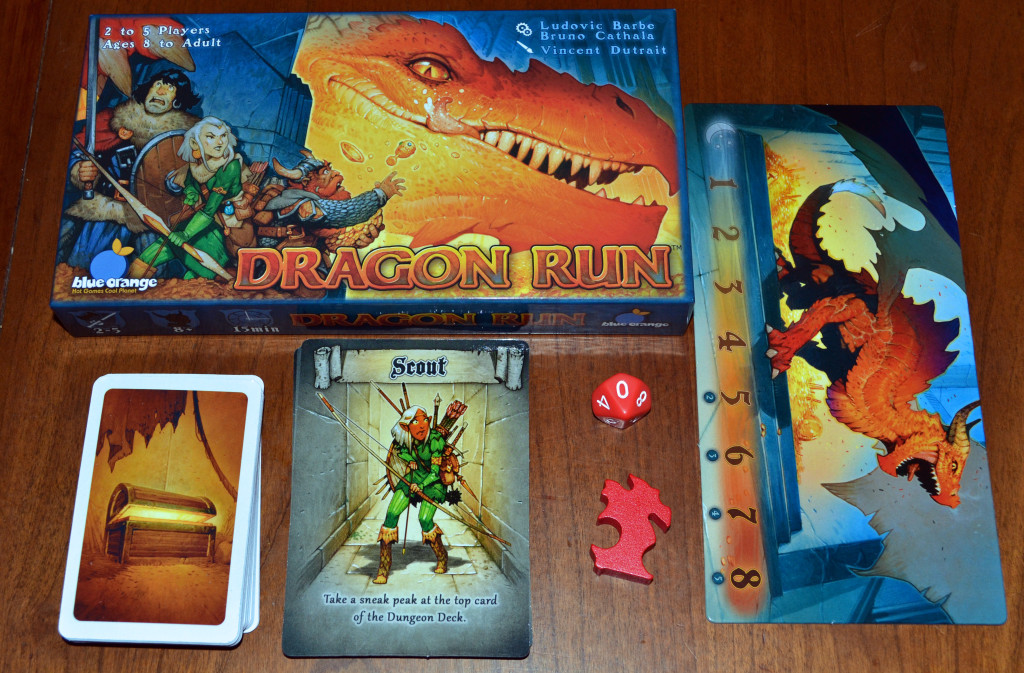Most dungeon-crawlers task players with entering a dungeon and finding treasure…but what happens when you finally get all that shiny stuff? “Dragon Run” addresses that very question, tasking players with…well, running! Players will be pushing their luck with the dungeon’s dragon, trying to escape with what they have in their possession. While leaving treasure behind is a valid way to not get scorched, players will have the opportunity to get more throughout the game (if they’re lucky enough). Before I go any further, I’d like to quickly thank the folks at Blue Orange Games for providing me with a press copy for review purposes.
Components
10 Location Cards, 38 Treasure Cards (29 objects with a gold coin value from 1 to 5 gold coins, and 9 potion and talisman cards), 7 Character Cards (With an “uninjured” side and an “injured” (shaded) side), 1 10-sided die (0 is considered nil, not 10), 1 Dragon Tile, and 1 Dragon Token
Setup & Gameplay
The dragon tile is placed in the center of the table, with the dragon token placed on a particular numbered space (depending on the number of players). Each player gets one character card (randomly or by choice) and places it in front of them uninjured side up. The ten location cards are shuffled to form the draw pile. The treasure cards are shuffled and four are dealt to each player…the rest form a draw pile. The “bravest” player goes first.
On a player’s turn, they must take one of the following three actions:
1. Charge Headfirst – The player draws from the location deck and places that card face up on top of the discard pile, applying its effects.
2. Advance Cautiously – The player discards a treasure card with a value of at least one point. After that, they take a discretion test. They’ll roll the die and…
A) If the result is higher than the number of location cards left in the draw pile, the dragon loses one temper point (the dragon token moves down a number). If the dragon loses his last temper point, the game ends. The player will then either “charge headfirst” or pass to the next player.
B) If the result is less than or equal to the number of location cards left in the draw pile, the active player MUST “charge headfirst”.
After one of these two results are resolved, all the location cards are shuffled back together to form a new draw pile.
3. Cry Like a Baby – The player passes their turn to the next player, discarding a treasure card with a total value of at least two points.
If a player ever gets “injured”, they’ll flip their character card to the injured side. If they were already injured and get injured again, they are out of the game. Also, each character has a unique power, which can be used before choosing an action. The card is tapped (rotated 90 degrees) when used and refreshed when the Dragon Location Card is drawn.
The game ends when the dragon loses its last temper point (when it reaches 0) or when all adventurers have been killed (in which case the dragon wins). In the case of the former, whichever survivor has the most gold coins (located on their treasure cards) wins the game!
Editor’s Note: The above doesn’t cover all of the rules found in the manual, but should give you a basic understanding of how the game is played.
The Review
“Dragon Run” is a push your luck game, through and through. Being that there are only ten location cards, the game obviously favors players who can keep track of the ones already drawn to determine what their chances are in getting scorched by the dragon. As an aside, some cards will force you to stop or keep going, mitigating your freedom of choice a bit. There’s not much to say about the game as it is very simple to play and will serve as a good, quick filler in between longer play sessions. It goes without saying that folks looking for an in-depth dungeon experience will not find it here.
Despite its simplicity, the game has a certain charm and appeal that I can’t quite put my finger on. Perhaps I can chalk it up to the fact that you never know when that dragon will appear, despite your attempts to calculate the odds with some fancy math. There’s a bit more emphasis in luck over strategy, though you can play it very safe and “advance cautiously” or “cry like a baby” often to limit the frequency at which you draw cards in order to be the last one standing. Even still, the times you do have to draw (because you have no treasure cards to give up) may do you in anyway. My recommendation is to not take the game too seriously and to just have fun with it. It’s a little pricey ($20+ on Amazon as of 7/24/15) for what it offers (even though the components are top notch), but I still think it does more right than wrong.
Final Verdict: 7/10
—


